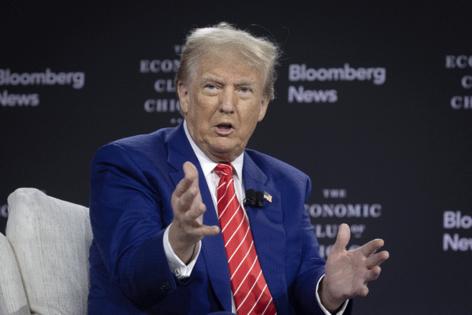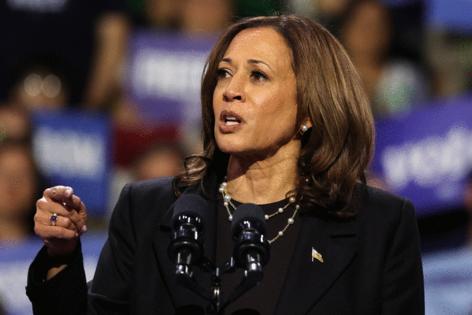Why you should stop looking at 2024 election polls in the coming weeks
Published in Political News
WASHINGTON — I watch polls for a living. I have one piece of advice for the next few weeks: Stop.
It’s not that polls are broken. Contrary to much criticism, surveys continue to provide remarkably accurate results and important insights into what different groups of voters think.
But most people relentlessly clicking on the latest, freshest surveys aren’t looking for that. They want to know — if you’re reading this, you probably want to know — the one answer that polls in a close race can’t provide: Who’s going to win.
Democrats’ anxiety runs amok
Over the past week, Democrats seem to have indulged in a coast-to-coast freakout over Vice President Kamala Harris’ chances in the presidential race.
That shift in mood says more about mass psychology than polling. The polls, on average, have barely wiggled, but in the final stretch, Democrats seem to be wired for anxiety much as Republicans lean toward overconfidence.
Reality check: Over the last 14 presidential elections, national polls have been off by an average of 2.2 percentage points. (Harry Enten, then of pollster FiveThirtyEight.com, first calculated that average in 2016.)
That’s not bad. The very best professional basketball players miss a free throw 10% of the time. Olympic archers miss the center ring at a similar rate. Being off by just a few percentage points over repeated elections in a country as diverse as the U.S. is pretty remarkable, and there’s no evidence that polls are growing less accurate; the average misses in 1996 and 2000, for example, were larger than any election since.
The problem, of course, is that tiny margins separate Harris from former President Donald Trump in key states. The average polling error is much bigger than either candidate’s edge. And given how few undecided voters remain, that’s not likely to change in these final two-and-a-half weeks.
What polls can tell us — less racial polarization
For the last several years, Democrats have gained ground among white, college-educated voters, and Republicans have picked up Black and Latino voters, especially those without a college degree and those who are religiously conservative.
That means U.S. politics has grown somewhat less polarized by race and ethnicity — a good thing. But that’s a tough pill for many people on the left, challenging their belief that voters of color naturally lean their way.
The key questions are how big these trends have gotten and how much each side has gained. Do the shifts offset each other, or has one party gained a significant advantage?
Because Harris is of mixed Black and Asian heritage, it surprises some people that it’s her strength among white voters that accounts for her apparent lead in the northern battleground states — Pennsylvania, Wisconsin and Michigan.
Conversely, in states where she lags, notably Arizona, weakness among white voters has been the main problem.
Polls by the New York Times and Siena College, which show her behind in Arizona, have found her lagging among white independents and moderate Republicans. Those surveys that show her ahead in the state, like a recent one from the Wall Street Journal, have found her doing better with precisely those groups, as Kyle Kondik of the University of Virginia’s Center for Politics noted in an analysis this week.
Trump, by contrast, has gotten a historically high level of support among Black voters, especially men, many surveys show.
Harris still wins an overwhelming majority of Black voters, 76% to 11%, with 8% uncertain in the latest Economist/YouGov survey, for example. But that’s significantly smaller than the 92% President Joe Biden won in 2020.
A question mark for Trump is whether the Black supporters who show up in polls will show up in the actual vote. Adam Carlson, a former Democratic pollster who has compiled data from multiple surveys, notes that polls in 2020 significantly overestimated Trump’s support among Black voters. That may be true again this year.
Among Latino voters, Harris now does about as well as Biden did in 2020 — 60% to 35% in the YouGov survey. That’s not as well as Democrats would like, but she has erased a deficit that was much larger in the spring. Many surveys, however, show a larger share of undecided voters among Latinos than among other groups.
Polling has been less widespread among Asian American voters, but a survey conducted in September by AAPI Data and NORC at the University of Chicago showed Harris leading Trump 66% to 28%, a significant improvement for the Democrats since Biden dropped out of the race.
And a huge gender gap
Gender, rather than ethnicity, appeared to be driving much of Harris’ support in that AAPI survey — she gained significant ground compared with Biden among Asian American women.
That’s consistent with other surveys that have found a very large gender gap this year. The gap rivals, maybe surpasses, the gulf in 2016, when Hillary Clinton’s campaign emphasized her status as the first woman to win a major party’s presidential nomination.
That year featured a 26-point gender gap: Clinton won women by 15 points, 54% to 39%, while Trump won men by 11 points, 41% to 52%, according to a detailed analysis by the Pew Research Center.
In 2020, the gender gap shrank, Pew found. Now it’s back. A recent NPR/Marist poll showed a 34-point gap, with Harris winning women by 18 points, while Trump won men by 16. That was on the high side of recent surveys, but on average, polls this fall have shown a 22-point gap, Carlson found.
One closely watched part of the gender gap involves young voters.
A New York Times/Siena College survey got a lot of attention for finding that men younger than 30 had shifted toward Trump while young women moved sharply toward Harris.
But as John Sides, a political scientist at Vanderbilt University, recently pointed out, other high-quality surveys have shown a much smaller youth gender gap, with both young men and young women supporting Harris.
Who’s right? The exit polls conducted by the big TV networks and the Associated Press will give us some preliminary clues, but we won’t know for sure until researchers can fully delve into the data, months after the votes get counted.
Underestimating Trump
’Round about now, someone reading this will say to themselves, “But don’t the polls always underestimate Republican votes?”
No.
In both 2000 and 2012, polls underestimated Democrats.
Polls did underestimate Trump’s vote in 2016. Afterward, pollsters examined what went wrong and set out to fix it.
They didn’t succeed: Surveys missed a lot of his supporters again in 2020.
So pollsters have tried new techniques to get the results right. Maybe they’ll succeed this time. Maybe they will undercount Trump voters again.
Or perhaps they’ve over-corrected, and the results now skew in the other direction.
We can expect there will be error; we don’t know which way it will fall.
Sorry, ‘internal’ polls won’t tell you, either
Don’t think you can hack your way to a better result by clicking on headlines about leaked internal surveys.
Yes, campaigns have more data than public pollsters.
But that’s no guarantee that they know better who will win. In 2012, for example, Mitt Romney’s campaign surveys told him he was ahead; he wasn’t prepared when President Barack Obama beat him. Romney is hardly alone in that — campaign surveys are subject to all the same limitations that public polls confront.
In fact, getting a precise fix on the horse race isn’t the top priority for a campaign pollster. Campaigns use polls primarily to test messages, trying to see which words will most effectively move groups of voters. That requires consistency from one survey to the next, not absolute precision on the topline.
And campaigns leak selectively. If they’ve conducted 20 polls in a close race, some almost surely will show their candidate behind, others will show them ahead — that’s how probability works. Experience shows they’ll leak whichever ones support the narrative they want to foster.
That’s why analysts who put together polling averages typically discount internal surveys by several points, as Nate Silver recently explained in detail.
This year, both campaigns seem intent on pushing the idea of Harris as the underdog. The vice president consistently embraces the label in her speeches, presumably hoping to motivate Democratic voters. Trump, of course, can’t abide being anything other than the top dog.
So it’s no surprise that both parties have leaked surveys showing Trump slightly ahead. Too bad that they don’t also distribute tranquilizers for anxious Democrats.
Who’s going to show up?
One big source of error for campaign polls — and a key reason that surveys differ from one another — is that pollsters are trying to measure a population that doesn’t yet exist, people who will vote in an election that hasn’t happened yet.
The bipartisan polling team that conducts surveys for NBC News recently ran an experiment to show the impact of pollsters’ assumptions about turnout.
Their most recent survey showed Harris and Trump tied nationwide, 48% to 48%, using the turnout model they had set up in advance.
But make just a few small tweaks in the turnout model — such as assuming women will make up 53% of the voters, rather than 52%, and that white voters will be 70% rather than 72% — and Harris would lead 49% to 46%. Similarly small tweaks in the other direction would put Trump ahead.
Making the right estimate gets especially complex when turnout is big. In low-turnout elections, the people who cast ballots are almost all regular voters with a consistent track record. High-turnout elections draw a lot of new voters.
In 2020, when turnout hit a record, about one in four voters hadn’t cast a ballot four years earlier, according to Pew’s data. This year, measures of voter enthusiasm suggest another high turnout in the offing, with all the uncertainty that brings to surveys.
So, anxious about the election? Go for a long walk. Watch the baseball playoffs. Or, if you feel committed, volunteer for your favored candidate. Knock on doors, make phone calls.
But if you want to stay sane, stop doomscrolling through polls. They’re not going to tell you what you want to know.
©2024 Los Angeles Times. Visit at latimes.com. Distributed by Tribune Content Agency, LLC.































































Comments